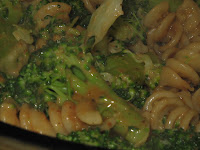After studying sauces in Cookwise and cooking up some familiar dishes, I realized that I do not, in fact, suck at making sauces. I'm actually quite good! We make these dishes regularly, all of which depend upon a good sauce: Chana Masala (tomato gravy puree), Garlicky Pasta (herb and garlic butter reduction), and Peanut Butter Broccoli (spicy peanut sauce). The truth is that I suck at making starch-based sauces, specifically for Asian dishes.
There are three basic sauce types – purees, reductions, and starch-based. Each works in a different way and complements certain dishes. Let's start at the top.
Purees
A puree is any food, cooked or raw, that has been blended to a thick consistency. Purees rely upon vegetables, fruit, cooked grains or beans, seeds, and bread crumbs for thickening. Purees should have a minimal amount of liquid since it can interfere with the blending and the final texture. 
Right now, you may be conceptualizing purees as those colorful sauce puddles next to gourmet meals. 
Purees infuse a dish with flavor. They should be used in dishes where the sauce is a critical component of the dish itself. You can use soy sauce instead of chili garlic in a stir-fry, for example, but you cannot separate Chana Masala from its signature tomato gravy, a puree. The Chana Masala recipe I use requires pureed tomato, chili, and ginger that is cooked with Indian spices and water. Purees must ramp up the flavor of their bland vegetable or grain base. You can add in spicy chilies, ginger, roasted nuts, Earth Balance, nutritional yeast, or something else with an intense flavor. In the Peanut Butter Broccoli dish, cayenne, soy sauce, and Worcestershire enhance the peanut butter base.
Puree Recap:
Veggies, fruit, rice, beans, seeds, and bread crumbs can all make the thick base.
Use a minimal amount of liquid.
Seek an intense flavor with chilies, ginger, or distinctive seasonings.
Reductions
OK, I want to give you a quick taste of reductions. A reduction sounds fancy, but the concept is simple enough. (Even if making a reduction may induce cursing).
A reduction is a sauce created from leftover flavors in your pan. Say you sauteed some vegetables in sage and oregano. Instead of throwing the vegetables over pasta when you're done, you could add some Earth Balance, scrape the seasonings off the pan, and add in new things to make a small amount of sauce for your dish. This is what I do when I make Garlicky Pasta. (No picture, sorry!)
To make a reduction, you must have already cooked something in the pan. (That something can stay in the pan if it's small or can be set aside if it's larger like a seitan cutlet). Deglaze the pan over medium heat. Deglazing is adding a liquid to the pan (wine, water, melted Earth Balance) and using it to scrape off seasonings that are stuck to the pan. Add in other flavors if you wish. Stir the sauce constantly, forcing it to touch all parts of the pan. Stirring infuses your reduction with more flavor as it grabs more and more flavor from the pan. Eventually you'll have a small amount of sauce to drizzle over seitan cutlets or stir-fry with cooked pasta.
If you're curious as to why reductions work: Chemical changes occur as the pan heats up; ingredients break down into new flavors. In my Garlicky Pasta dish, the sage and oregano intensify in flavor and the onions caramelize. The flip side of reductions is that the liquid removes bitterness. As water reaches its boiling point, part of it evaporates and carries away acids and other bitter molecules that have lower boiling points. Pretty cool, huh?
Redux Recap:
- Use a pan you just cooked something in
- Deglaze the pan with a liquid like water, wine, or margarine
- Stir constantly, touching all parts of the pan
- Add in other ingredients, if desired
Starch-Based Sauces
I'll save this for next week. I'm going home for the weekend and won't be in the kitchen for awhile. Don't worry, I am looking forward to a cooking break and lots of Indian takeout from Madison.

No comments:
Post a Comment